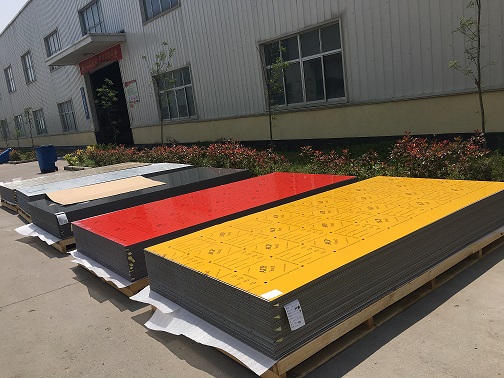Why is Aluminum Composite Panel (ACP) Becoming the Go-To Material for Modern Architecture?
2024-12-26
In the world of modern architecture and construction, materials play a critical role in defining both the functionality and aesthetics of a building. One material that has gained significant popularity in recent years is the Aluminum Composite Panel (ACP). Known for its versatility, durability, and sleek appearance, ACP is increasingly being used in a wide variety of applications, from building facades to interior design. But why is ACP becoming the go-to material for modern architecture? Let’s explore the features, benefits, and uses of Aluminum Composite Panels and why they are a preferred choice for architects and designers alike.
1. What Is an Aluminum Composite Panel (ACP)?
An Aluminum Composite Panel is made up of two thin layers of aluminum enclosing a non-aluminum core, typically composed of polyethylene or a mineral core. The outer layers of aluminum offer strength, protection, and aesthetic appeal, while the inner core provides flexibility and insulation. ACPs are available in a wide range of finishes, colors, and textures, making them an incredibly versatile material for both exterior and interior applications.
2. What Are the Key Benefits of Using Aluminum Composite Panels?
There are numerous reasons why ACPs are favored in modern architectural design. Some of the most compelling benefits include:
- Lightweight and Durable: Despite their sleek, metallic appearance, ACPs are lightweight yet durable. This makes them easier to handle and install compared to solid metal or stone materials, without compromising on strength and longevity.
- Aesthetic Appeal: ACPs offer a high degree of aesthetic flexibility. With various finishes like matte, glossy, brushed, and textured, along with an extensive range of colors, they can mimic natural materials like wood, stone, and even glass, providing architects with countless design options.
- Weather Resistance: ACPs are designed to withstand harsh weather conditions. The aluminum surface is corrosion-resistant, ensuring that the panels maintain their appearance and integrity over time, even when exposed to the elements.
- Easy to Maintain: Due to their smooth surface, ACPs are easy to clean and maintain. They resist dirt accumulation, mold, and pollutants, making them a practical choice for buildings in urban areas or places with high humidity.
- Energy Efficiency: The core of the ACP often provides some degree of insulation, improving the energy efficiency of the building. ACPs help to reduce heat transfer, thus contributing to better temperature control and energy savings.
- Fire-Resistant Options: Some ACPs, especially those with mineral cores, are highly fire-resistant, which is an essential quality for ensuring the safety and longevity of buildings, especially in commercial and public spaces.
3. How Are Aluminum Composite Panels Used in Modern Architecture?
Aluminum Composite Panels are incredibly versatile and can be used in a variety of architectural applications:
- Building Facades: ACPs are often used for cladding the exterior of buildings. Their lightweight nature makes them ideal for high-rise structures, while their ability to withstand extreme weather conditions ensures that they provide long-lasting protection.
- Interior Walls: ACPs are also used in interior applications, particularly in commercial spaces like offices, malls, and airports. Their sleek finish adds a modern touch to interior designs, while their durability ensures they stand up to wear and tear.
- Signage and Branding: The flexibility of ACPs makes them a popular choice for creating outdoor signage, hoardings, and brand facades. The panels can be easily cut into custom shapes and printed with logos and designs.
- Partitions and Ceilings: ACPs are often used for room partitions and ceiling panels, providing both privacy and acoustic benefits. Their durability ensures that they maintain their appearance even in high-traffic areas.
- Curtain Walls: ACPs are frequently used in curtain wall systems, which are non-structural exterior walls that hang like a curtain. This allows for a building to have large windows and transparent walls while still maintaining insulation and protection from the elements.
4. Why Is ACP a Sustainable Choice for Architects?
Sustainability is a growing concern in the construction industry, and architects are increasingly looking for materials that not only perform well but also have a reduced environmental impact. ACPs meet these needs in several ways:
- Recyclable: Aluminum is a highly recyclable material, and many ACPs are made with a significant percentage of recycled aluminum. This makes them a more sustainable choice compared to other materials that may have a higher carbon footprint.
- Durability: The longevity of ACPs means that buildings designed with this material require fewer repairs or replacements over time. This contributes to the overall sustainability of the building by reducing waste and resource consumption.
- Energy Efficiency: As mentioned, ACPs help improve the energy efficiency of buildings, which can reduce the overall energy consumption of a structure. This contributes to a building's green building certifications, such as LEED.
- Reduced Maintenance: The low maintenance requirements of ACPs mean that fewer chemicals, cleaners, or materials are needed to keep them in good condition, further reducing their environmental impact over time.
5. What Are the Challenges of Using Aluminum Composite Panels?
While ACPs have numerous advantages, it’s important to consider a few challenges before choosing them for your project:
- Initial Cost: ACPs can be more expensive than some other cladding materials, although the long-term benefits often outweigh the initial investment.
- Susceptibility to Dents: Although ACPs are durable, they can be susceptible to dents and scratches if impacted by sharp objects or heavy forces. However, the damage can often be repaired or replaced easily.
- Environmental Impact of the Core Material: While the aluminum outer layers are highly recyclable, some types of ACPs with polyethylene cores may pose environmental challenges at the end of their life cycle. Choosing ACPs with mineral cores can help address this issue.
6. How to Choose the Right Aluminum Composite Panel for Your Project?
When selecting ACPs for a building project, consider the following factors:
- Finish and Appearance: Choose a finish that complements the architectural style of the building and meets aesthetic requirements.
- Fire Resistance: Depending on the building’s purpose, it may be essential to choose fire-resistant ACPs to comply with safety regulations.
- Core Material: Consider the environmental impact and performance characteristics of the core material when making a selection.
- Thickness and Durability: Ensure that the ACPs are thick enough to withstand environmental stress, such as wind and rain, especially in areas with extreme weather.
Conclusion
Aluminum Composite Panels have proven to be an essential material for modern architecture, offering a blend of aesthetic appeal, durability, energy efficiency, and sustainability. Their versatility makes them suitable for a wide range of applications, from building facades to interior design elements. With the increasing demand for environmentally friendly and efficient building materials, it’s no wonder that ACPs are becoming the material of choice for architects worldwide.



